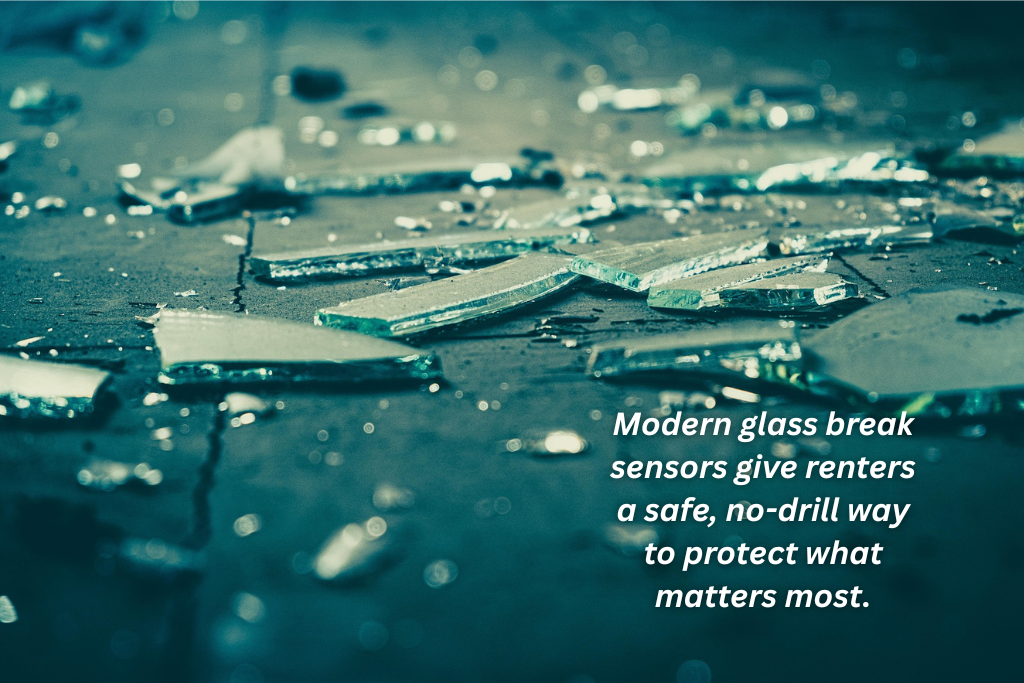
Top 5 Glass Break Sensors for Smart Homes, a 2025 Guide
Glass doors and windows feel like an open invitation to burglars. They are easy to break and hard to secure. Apart from that, things become even riskier when you are a renter because you cannot upgrade without landlord approval. Your privacy concerns, safety fears for kids and pets make the glass entry points, one of the biggest sources of stress.
Since glass can be shattered quickly compared to solid doors or walls, intruders might target it to gain access in seconds. Renters are concerned because they cannot replace glass doors and windows with stronger materials, as they do not own the property. Moreover, most landlords won’t allow drilling or the installation of permanent security devices. Those basic locks and thin glass left you feeling stuck, searching for non-invasive and removable solutions.
That’s why protecting glass doors and windows has become as important as securing entry doors. Glass break sensors add an extra layer of security. These sensors detect the unique sound or vibration of breaking glass. The market is full of glass break sensors, which are available as wireless, app-controlled, and miniature versions. They are designed according to the needs and budgets. In this guide, you will explore the top five glass break sensors and their features to choose the most suitable one.
What are the Key Features to Consider in Glass Break Sensors?
You should be careful about the factors that affect your selection of these sensors. For instance, check the sensitivity of these sensors. Choose one that detects true glass break events and minimizes false alerts from loud noises or pets. Then comes the range of sensors. Look for the models that cover the right distance for your room size.
Also consider the power factor. Battery-powered sensors offer flexibility, while wired models may suit permanent setups. Ensure the sensor is easy to install and works with your existing smart home system for seamless integration.
Top 5 Glass Break Sensors for Smart Homes
Here’s a brief explanation of the top glass break sensors. Please read thoroughly, as along with the features, we have also discussed the potential issues users usually experience with each device. This will help you get an idea of whether your chosen device is suitable for you or not.
1. Vivint Glass Break Detector
The Vivint Glass Break Detector offers reliable home security and alerts you instantly. It detects the sound of breaking glass and is designed to provide a reliable safety solution. However, despite Vivint’s security design and functionality, there are some concerns. It is not about the device but includes the company’s sales model, contract, and customer support. We found that the customers are satisfied with the device functionality, but there are complaints about aggressive and dishonest sales tactics. This counts for the overpromising, changing prices later, misrepresenting features, and pushing contracts. The customer support is slow, and the installation quality is good when done by the company and poor when done by 3rd parties. The positive reviews state that discounts are often available, especially if you use referrals. Also, you can pay for equipment up front to avoid being trapped in a long-term contract.
Key Features
- Uses advanced frequency recognition to distinguish glass breaking from other loud noises like thunder or dishes.
- Monitors windows and glass doors within 20 feet.
- Battery-powered for flexible placement.
- It also integrates with Vivint smart hubs.
- Requires professional installation for optimal setup and performance.
Pros
- Highly accurate detection. This device has minimal false alarms.
- Integrates perfectly with Vivint smart home systems.
- Offers reliable coverage within 20 feet.
- Battery-powered for convenient placement without wiring.
Cons
- Requires professional installation.
- Limited to the Vivint ecosystem but not compatible with third-party hubs.
- Higher price point compared to some standalone detectors.
2. Honeywell 5853 Wireless Glass Break Detector
Honeywell 5853 provides adjustable sensitivity and comprehensive system compatibility. It is designed for home owners and tenants who want reliable protection without professional installation. For most users, Honeywell 5853 offers optimal performance and good values, especially if you are dialing comfortably in the right sensitivity setting. The medium or lower sensitivity settings can significantly reduce false alarms while still offering strong detection. If you’re using a monitored security system, check whether you can self-install or if your provider requires their own replacement equipment. However, a few users report that it becomes overly sensitive at high settings. Some users also report frequent false alarms regardless of sensitivity settings. A few customers reported unexpected behavior or receiving pre-used products.
Key Features
- Adjustable sensitivity settings allow you to fix the detector to reduce false alarms from everyday domestic noise.
- Covering multiple windows in the same room, the glass breaking within a 25-foot radius.
- Battery operates with an impressive 10-year battery life for the operation of low maintenance.
- The DIY was designed for installation, making it easy to mount special equipment without professional help.
Pros
- Adjustable sensitivity helps minimize false alarms.
- Broad range of up to 25 feet covers larger rooms.
- Long-lasting battery reduces maintenance needs.
- Compatible with various DIY systems for flexible use.
Cons
- No built-in app control or smart hub features.
- Requires manual adjustment to optimize sensitivity.
- More basic compared to modern app-connected sensors.
3. Aqara Vibration Sensor
The aqara Vibration Sensor offers compact, wireless, and highly compatible glass break detection sensors. It is perfect for renters or smart home owners who want precise and low-maintenance security. The general sentiments of users is satisfied and happy with the versatility of this sensor. They find this device useful beyond its advertised purpose and also repurpose it for all kinds of smart-home automation. They are using it to mount on washing machines and dryers to get notified when cycles finish. This device is very flexible, but there are minor bugs that need software updates.
Key Features
- Detects vibrations and tilts, reducing missed events while avoiding common sound-based false triggers.
- Small but highly targeted. You can mount it directly to the glass or frame for localized detection.
- A battery-powered Zigbee sensor that operates efficiently.
- Works seamlessly with Apple HomeKit, Alexa, and IFTTT for flexible automation.
- Quick stick-on mounting with adhesive, no tools required.
Pros
- Highly targeted detection minimizes missed break-ins.
- Compact and discreet design.
- Works with multiple smart platforms for versatile automation.
- Easy installation with no drilling or wiring.
Cons
- Limited detection.
- Requires a Zigbee hub for full smart functionality.
- Not ideal for very large or noisy rooms compared to sound-based detectors.
4. SABRE Window Glass Break & Vibration Alarm
The SABRE Window Glass Break and Vibration alarm is a simple, budget-friendly way to secure windows. It works as a standalone device. It produces a loud alarm when it detects glass vibration or breaking. This makes it perfect for renters who do not want a complex smart system. It is best for wide-area coverage, and acoustic glass break sensors are worth it despite being pricer.
Key Features
- Adjustable sensitivity helps balance responsiveness with fewer false alarms. Emits a piercing 110dB siren when triggered.
- Localized coverage designed for individual windows, ensuring targeted protection.
- Battery-powered, so it keeps working even during power outages.
- Standalone device and requires no Wi-Fi, hub, or app.
- Peel-and-stick design.
Pros
- Affordable and effective for single-window protection.
- Extremely loud alarm deters intruders immediately.
- Portable and easy to remove, ideal for renters or frequent movers.
- No setup complexity or internet dependency.
Cons
- No smart features or app notifications.
- Limited coverage.
- Manual arming/disarming may be less convenient than smart systems.
5. ADT Glass Break Sensor
The ADT Glass Break Sensor is designed for homeowners and renters who have already used or plan to use ADT-monitored security systems. It is perfect to listen to the specific sound frequency of breaking glass. This offers an extra layer of perimeter protection. This device is also seamlessly integrated with the wider ADT ecosystem. However, when we talk about reviews, it’s a debate between users who have had no problems and users who have had nightmares with consistent false alarms. Since it is a 50/50 split, which means the product works well in the right conditions but is very sensitive to environment and placement.
Key Features
- Many sensitivity levels allow technicians to fine-tune it in your environment, reducing false alarms.
- The glass breaks up to 25 feet away, covering several windows within the same room.
- Battery-operated for flexible placements and reliable operations during power outage.
- ADT Smart Safety works within the safety platform and can be monitored professionally
Pros
- Seamless integration with ADT’s 24/7 monitoring and smart home system.
- Wide coverage area.
- Professionally configured for accuracy and reliability.
Cons
- Professional installation only.
- Typically available only through an ADT service plan, adding a monthly cost.
- Less portable than standalone or peel-and-stick options.
Comparison Table of Top 5 Glass Break Sensors for Renters
| Feature | Vivint Glass Break Sensor | Honeywell 5853 Wireless | Aqara Vibration Sensor | SABRE Window Glass Break & Vibration Alarm | ADT Glass Break Sensor |
| Detection Type | Acoustic (dual-shatter + sound) with some vibration sensing | Acoustic (glass-shatter detection) | Shock/vibration (detects movement/vibration) | Shock/vibration (tamper or break detection) | Acoustic (glass-break detection) (typical ADT approach) |
| Coverage / Range | 20-ft radius, 360° horizontal coverage | Covers multiple panes; one device for a room | One sensor per object/window | Alarm is audible up to 700 ft; covers only the attached window | Typically similar acoustic coverage (not specified) |
| Sensitivity Settings | 3 levels: Low, Medium, High | Adjustable sensitivity (some flexibility) | Adjustable (via app/rules) | High/Low sensitivity setting | Typically adjustable sensitivity (not specified) |
| Installation / Mounting | Wall or ceiling; professional install standard | Wall-mount; uses double tape or screws | Adhesive on or near the object/window | Stick-on, direct attachment to glass frame/window | Wall-mount or near glass, DIY-friendly |
| Power / Battery Life | 2 × CR123A batteries; 3-5 years | Battery powered; long battery life noted by users | Battery powered (typical for Aqara sensors) | Battery powered; not specified | Battery powered (typical for ADT sensors) |
Conclusions
The verified market research and reports suggest that the glass break sensor market is steadily growing. This will open new options for homeowners and renters to upgrade their security. Today’s sensors are smaller and sleeker. However, remember that if you go for wire-free setups, they will be easy to reinstall and relocate. The selection of the right model depends on your home’s size, layout, and smart home integration. With the right choice, you’ll strengthen your home security.
FAQs
Can you use a glass break sensor in a residential location?
Yes, you can use glass break sensors in a residential location. In fact, using them will enhance your home security.
How do I get Google Home to detect glass breaks?
To enable Google Home to detect glass break, follow these steps:
- Go to the Google Home App
- Open Settings and go to Subscription
- Click on Nest Aware and select the sound detection
- Make sure that Glass Breaking is checked under the ‘Sounds’ section
What is the maximum range of a glass break sensor?
The maximum range of a glass break sensor is 20 ft.




